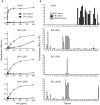Preferential recognition of avian-like receptors in human influenza A H7N9 viruses
- PMID: 24311689
- PMCID: PMC3954636
- DOI: 10.1126/science.1243761
Preferential recognition of avian-like receptors in human influenza A H7N9 viruses
Abstract
The 2013 outbreak of avian-origin H7N9 influenza in eastern China has raised concerns about its ability to transmit in the human population. The hemagglutinin glycoprotein of most human H7N9 viruses carries Leu(226), a residue linked to adaptation of H2N2 and H3N2 pandemic viruses to human receptors. However, glycan array analysis of the H7 hemagglutinin reveals negligible binding to humanlike α2-6-linked receptors and strong preference for a subset of avian-like α2-3-linked glycans recognized by all avian H7 viruses. Crystal structures of H7N9 hemagglutinin and six hemagglutinin-glycan complexes have elucidated the structural basis for preferential recognition of avian-like receptors. These findings suggest that the current human H7N9 viruses are poorly adapted for efficient human-to-human transmission.
Figures





References
-
- World Health Organization. Overview of the emergence and characteristics of the avian influenza A (H7N9) virus, 2013. http://www.who.int/influenza/human_animal_interface/influenza_h7n9/WHO_H....
-
- Gao R, et al. Human infection with a novel avian-origin influenza A (H7N9) virus. N Engl J Med. 2013;368:1888. - PubMed
-
- Li Q, et al. Preliminary report: epidemiology of the avian influenza A (H7N9) outbreak in China. N Engl J Med. 2013 Epub ahead of print.
Publication types
MeSH terms
Substances
Associated data
- Actions
- Actions
- Actions
- Actions
- Actions
- Actions
Grants and funding
LinkOut - more resources
Full Text Sources
Other Literature Sources
Medical

